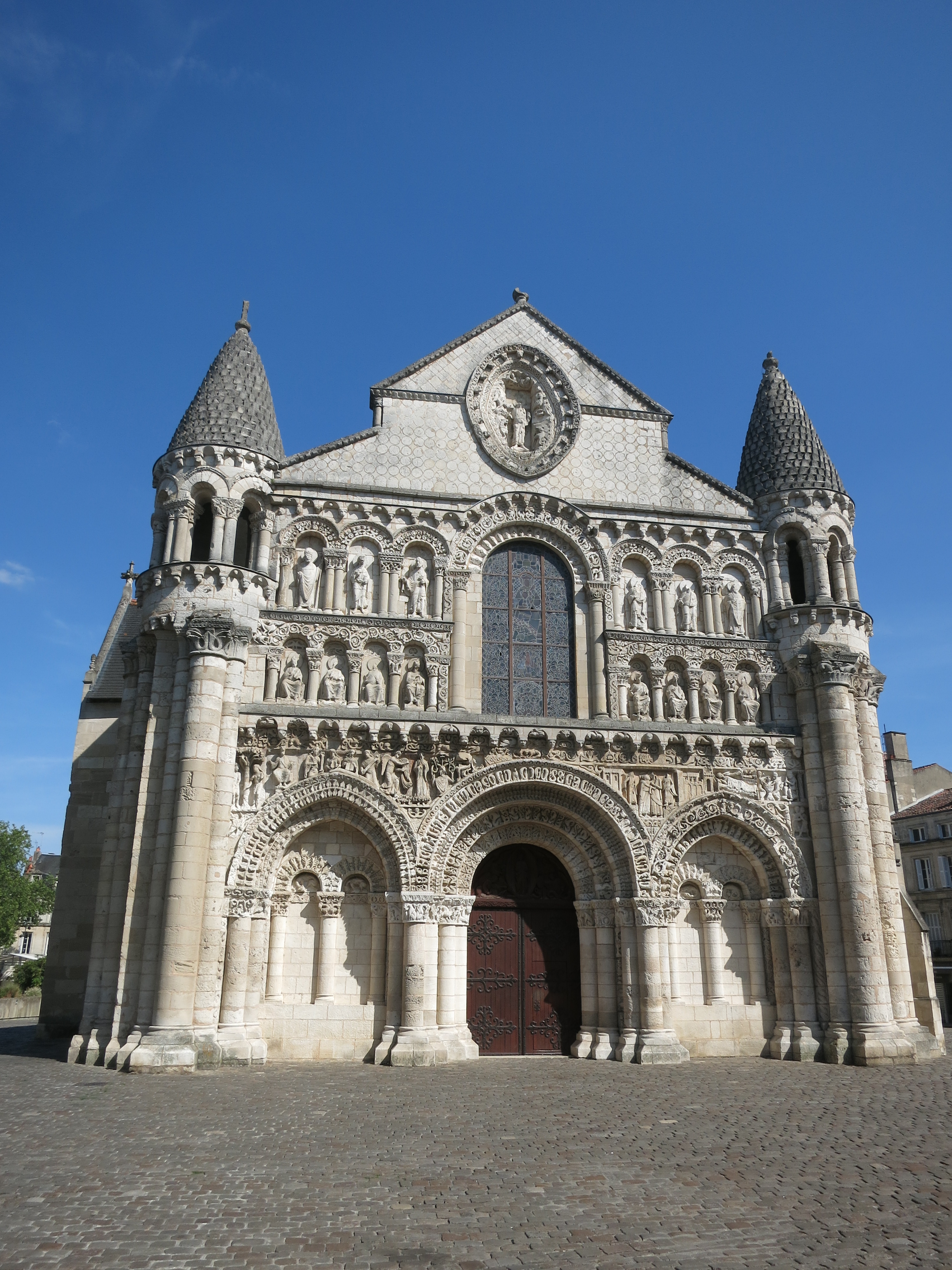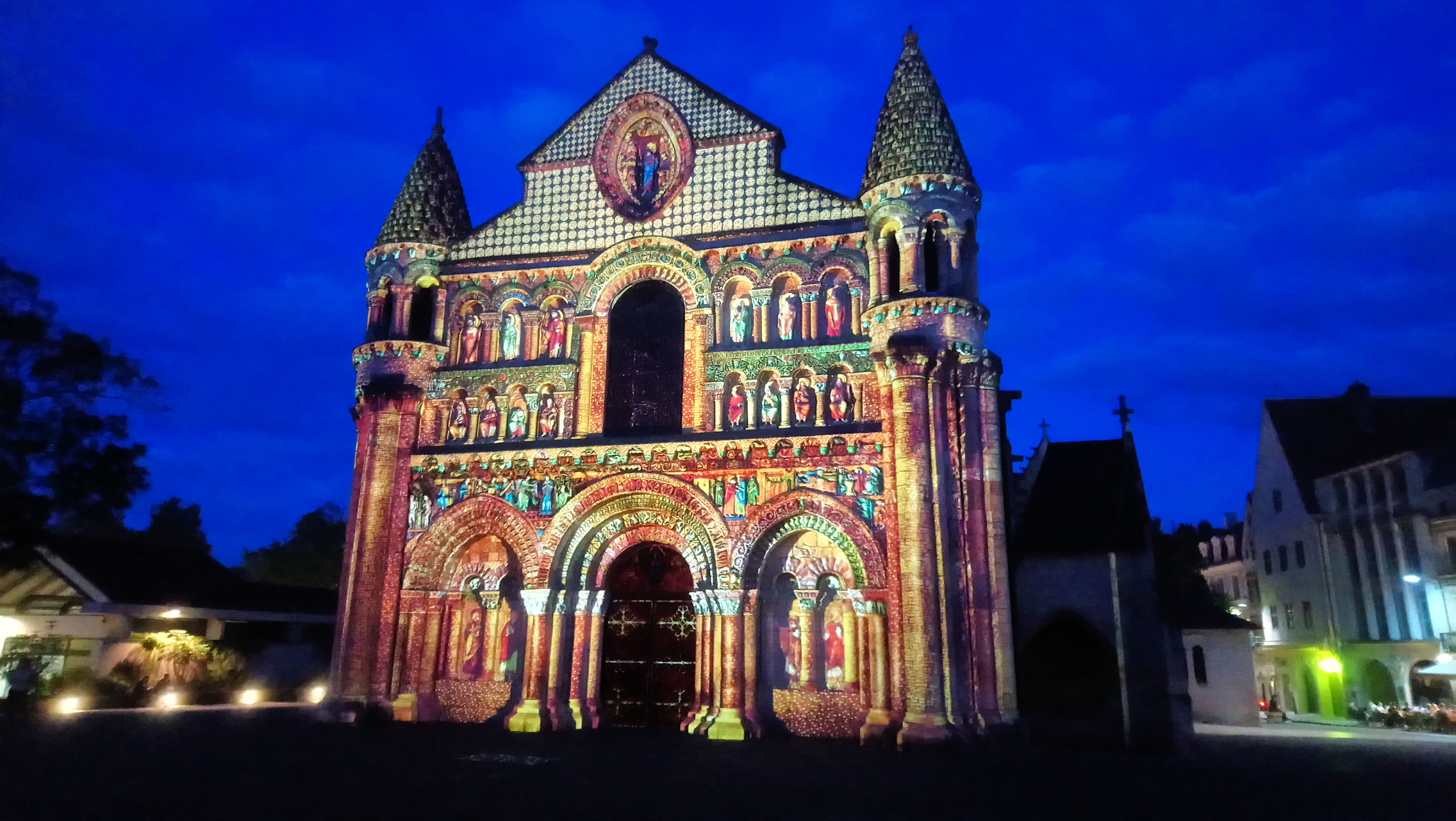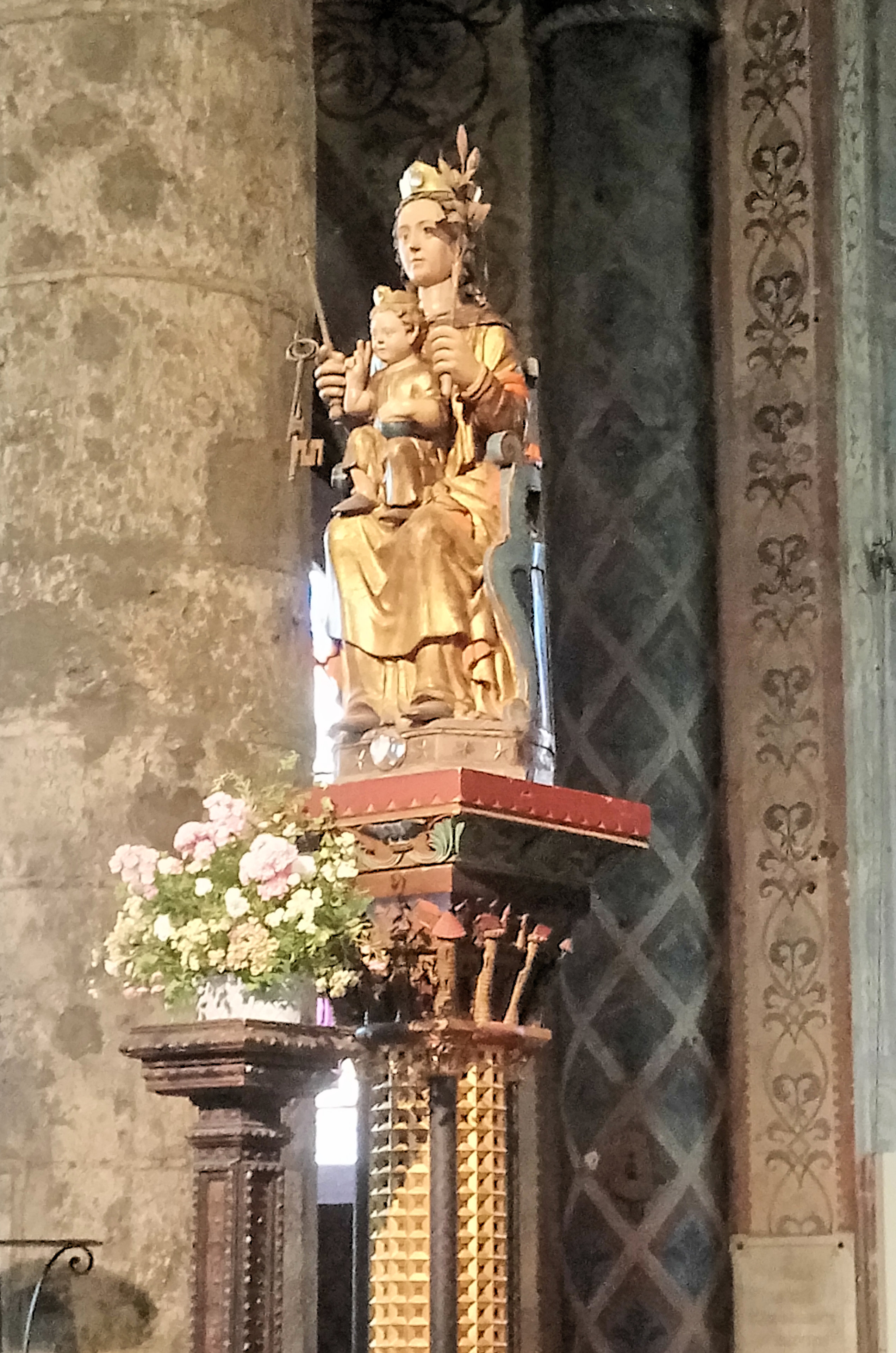

Notre-Dame-la-Grande est mentionnée pour la première fois au Xe siècle, sous le nom latin Sancta Maria Major en référence à l'église Sainte-Marie-Majeure de Rome. Rebâtie au XIe siècle, elle est consacrée par le futur pape Urbain II lors de son passage à Poitiers en juillet 1086.
La célèbre façade-écran de style roman poitevin, illustrant des pages de la Bible, est réalisée vers 1115-1130. Tout au long des XVe et XVIe siècles, différentes chapelles privées sont aménagées du côté nord de l'église, comme la chapelle Sainte-Anne, dite Chapelle du Fou. Celle-ci abrite, depuis 1802, une mise au tombeau en pierre polychrome des années 1500 provenant de l'ancienne abbaye de la Trinité de Poitiers. En 1562, le bâtiment subit les destructions des Huguenots qui pillent l'édifice, brûlent les reliques et décapitent la plupart des statues de la façade.

De toutes les églises romanes de Poitiers, Notre-Dame-la-Grande est celle qui a le mieux conservé son plan et sa silhouette romane. N'ayant pas de transept, elle n'a pas la forme en croix latine de la plupart des églises. Le choeur est entouré de six colonnes aux chapiteaux corinthiens, puis d'un déambulatoire et de chapelles rayonnantes. Une petite crypte a été aménagée, a posteriori, sous le choeur au XIe siècle.
De la période romane, seuls subsistent quelques vestiges de décor peint dans le chœur. Elle possède un grand nombre de vitraux, dont celui du Miracle des Clefs qui orne la chapelle Bardeau. Dans le choeur se trouve une statue de la Vierge à l'Enfant, appelée Notre-Dame-des-Clefs.

Depuis 1995, chaque soir d'été et pendant les vacances de Noël, à la tombée de la nuit, la façade de l'église Notre-Dame-la-Grande de Poitiers se pare de couleurs et renoue avec son passé d'église peinte.
La légende du Miracle des Clefs

En l'an 1202, les Anglais assiégeaient la ville de Poitiers. Le clerc du maire leur promet de leur livrer la ville en leur fournissant les clés de la ville en échange d'une grande somme d'argent, et ce, le jour de Pâques.
Dans la nuit, le clerc rentre dans la chambre du maire pour lui voler les clés mais, au moment de les saisir, elles avaient disparu.
À son réveil, le maire se rend également compte de la disparition et, effrayé, sait qu'il y a eu trahison. Il prévient donc son armée et se rend à Notre-Dame-la-Grande pour prier. Il y découvre la statue de la Vierge Marie, les clés en main. Pendant la nuit, sous les remparts, effrayés par les apparitions de la Vierge, de Saint-Hilaire et de Sainte-Radegonde, les Anglais se sont entretués et se sont enfuis.
Cette légende est représentée dans l'église sur un vitrail du XIXe siècle et sur un tableau du XVIIe siècle.
(Sources : http://www.ot-poitiers.fr, https://fr.wikipedia.org)

Pour valider votre découverte, il vous suffit de joindre à votre log « found it » une photo prise sur place et comportant impérativement les 3 éléments suivants:
- Vous, de face, de dos, en entier, en partie … Les photos montrant les visages sont totalement facultatives, pour garantir la confidentialité de chacun
- Un élément de l’église Notre Dame (façade, statue de Notre Dame, porche …)
- Votre pseudo Geocaching écrit sur le support de votre choix.
De manière facultative, vous pouvez y ajouter un objet personnel (par exemple, pour rester dans l'esprit de cette virtuelle, vous pouvez y ajouter une clé, une photo de clé, ou un dessin de clé en vous inspirant de la photo ci-dessous).

Vous n'avez pas besoin de m'envoyer votre photo par messagerie, je vous contacterais en cas de problème.
Tout log non accompagné de cette photo sera supprimé.

Notre-Dame-la-Grande is mentioned for the first time in the 10th century, under the Latin name Sancta Maria Major in reference to the Church of Santa Maria Maggiore in Rome. Rebuilt in the 11th century, it was consecrated by the future Pope Urban II during his visit to Poitiers in July 1086.
The famous facade-screen Romanesque poitevin, illustrating pages of the Bible, is made around 1115-1130. Throughout the fifteenth and sixteenth centuries, various private chapels are located on the north side of the church, like the chapel of St. Anne, said Chapel of the Fool. It houses, since 1802, a burial in polychrome stone from the 1500s from the former Abbey of the Trinity of Poitiers. In 1562, the building suffered the destruction of the Huguenots who plunder the building, burn relics and decapitate most of the statues of the facade.
Of all the Romanesque churches of Poitiers, Notre-Dame-la-Grande is the one that has best preserved its plan and its Romanesque silhouette. Having no transept, it does not have the Latin cross shape of most churches. The choir is surrounded by six columns with Corinthian capitals, then with an ambulatory and radiant chapels. A small crypt was built, a posteriori, under the choir in the eleventh century.
From the Romanesque period, only a few remains of painted decoration remain in the choir. It has a large number of stained glass windows, including that of the Miracle of the Keys that adorns the shingle chapel. In the choir is a statue of the Virgin and Child, called Our Lady of the Keys.
Since 1995, every summer evening and during the Christmas holidays, at dusk, the facade of the Notre-Dame-la-Grande church in Poitiers is adorned with colors and revives its painted church past .
The legend of the Miracle of the Keys
In the year 1202, the English besieged the city of Poitiers. The cleric of the mayor promises to deliver the city by providing them with the keys of the city in exchange for a large sum of money, and this, on Easter day.
In the night, the clerk returned to the chamber of the mayor to steal the keys but, when seizing them, they had disappeared.
When he wakes up, the mayor is also aware of the disappearance and, frightened, knows that there has been treason. He therefore warns his army and goes to Notre-Dame-la-Grande to pray. He discovers the statue of the Virgin Mary, keys in hand. During the night, under the ramparts, frightened by the apparitions of the Virgin, Saint-Hilaire, and Sainte-Radegonde, the English slain each other and fled.
This legend is represented in the church on a stained glass window of the nineteenth century and on a painting of the seventeenth century.

To validate your discovery, simply attach to your log "found it" a photo taken on site and must include the following 3 elements:
- You, front, back, in full, in part ... The pictures showing the faces are completely optional, to ensure the privacy of each
- An element of the Notre Dame church (facade, statue of Notre Dame, porch ...)
- Your Geocaching nickname written on any support.
Optionally, you can add a personal object (for example, to stay in the spirit of this virtual geocache, you can add a key, a photo, or a drawing of a key).
You do not need to send me your picture by mail, I will contact you in case of problems.
Any log not accompanied by this photo will be deleted.
Virtual Reward - 2019/2020
Cette cache fait partie des 4000 nouvelles caches virtuelles qui ont été créées et publiées entre le 4 juin 2019 et le 4 juin 2020. Pour en savoir plus sur ces caches, rendez-vous sur le Blog Geocaching.
This Virtual Cache is part of a limited release of Virtuals created between June 4, 2019 and June 4, 2020. Only 4,000 cache owners were given the opportunity to hide a Virtual Cache. Learn more about Virtual Rewards on the Geocaching Blog.